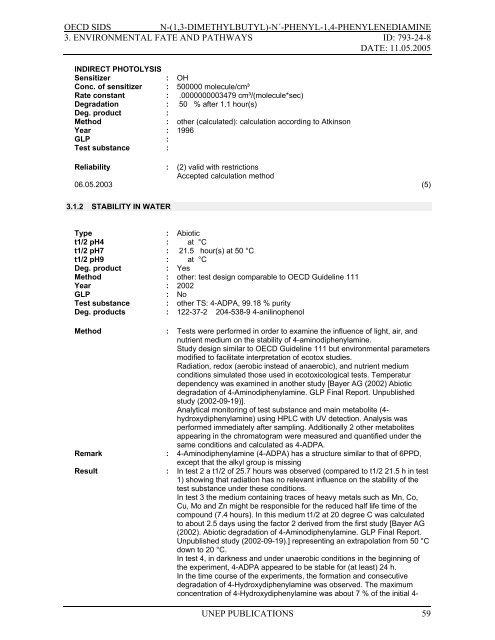N-(1,3-Dimethylbutyl)-N
N-(1,3-Dimethylbutyl)-N
N-(1,3-Dimethylbutyl)-N
Create successful ePaper yourself
Turn your PDF publications into a flip-book with our unique Google optimized e-Paper software.
OECD SIDS<br />
N-(1,3-DIMETHYLBUTYL)-N´-PHENYL-1,4-PHENYLENEDIAMINE<br />
3. ENVIRONMENTAL FATE AND PATHWAYS ID: 793-24-8<br />
DATE: 11.05.2005<br />
INDIRECT PHOTOLYSIS<br />
Sensitizer : OH<br />
Conc. of sensitizer : 500000 molecule/cm³<br />
Rate constant : .0000000003479 cm³/(molecule*sec)<br />
Degradation : 50 % after 1.1 hour(s)<br />
Deg. product :<br />
Method : other (calculated): calculation according to Atkinson<br />
Year : 1996<br />
GLP :<br />
Test substance :<br />
Reliability : (2) valid with restrictions<br />
Accepted calculation method<br />
06.05.2003 (5)<br />
3.1.2 STABILITY IN WATER<br />
Type : Abiotic<br />
t1/2 pH4 : at °C<br />
t1/2 pH7 : 21.5 hour(s) at 50 °C<br />
t1/2 pH9 : at °C<br />
Deg. product : Yes<br />
Method : other: test design comparable to OECD Guideline 111<br />
Year : 2002<br />
GLP : No<br />
Test substance : other TS: 4-ADPA, 99.18 % purity<br />
Deg. products : 122-37-2 204-538-9 4-anilinophenol<br />
Method : Tests were performed in order to examine the influence of light, air, and<br />
nutrient medium on the stability of 4-aminodiphenylamine.<br />
Study design similar to OECD Guideline 111 but environmental parameters<br />
modified to facilitate interpretation of ecotox studies.<br />
Radiation, redox (aerobic instead of anaerobic), and nutrient medium<br />
conditions simulated those used in ecotoxicological tests. Temperatur<br />
dependency was examined in another study [Bayer AG (2002) Abiotic<br />
degradation of 4-Aminodiphenylamine. GLP Final Report. Unpublished<br />
study (2002-09-19)].<br />
Analytical monitoring of test substance and main metabolite (4-<br />
hydroxydiphenylamine) using HPLC with UV detection. Analysis was<br />
performed immediately after sampling. Additionally 2 other metabolites<br />
appearing in the chromatogram were measured and quantified under the<br />
same conditions and calculated as 4-ADPA.<br />
Remark : 4-Aminodiphenylamine (4-ADPA) has a structure similar to that of 6PPD,<br />
except that the alkyl group is missing<br />
Result : In test 2 a t1/2 of 25.7 hours was observed (compared to t1/2 21.5 h in test<br />
1) showing that radiation has no relevant influence on the stability of the<br />
test substance under these conditions.<br />
In test 3 the medium containing traces of heavy metals such as Mn, Co,<br />
Cu, Mo and Zn might be responsible for the reduced half life time of the<br />
compound (7.4 hours). In this medium t1/2 at 20 degree C was calculated<br />
to about 2.5 days using the factor 2 derived from the first study [Bayer AG<br />
(2002). Abiotic degradation of 4-Aminodiphenylamine. GLP Final Report.<br />
Unpublished study (2002-09-19).] representing an extrapolation from 50 °C<br />
down to 20 °C.<br />
In test 4, in darkness and under unaerobic conditions in the beginning of<br />
the experiment, 4-ADPA appeared to be stable for (at least) 24 h.<br />
In the time course of the experiments, the formation and consecutive<br />
degradation of 4-Hydroxydiphenylamine was observed. The maximum<br />
concentration of 4-Hydroxydiphenylamine was about 7 % of the initial 4-<br />
UNEP PUBLICATIONS 59
















